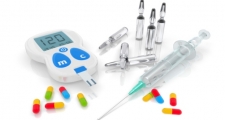What is the treatment for diabetes?
The major goal in treating diabetes is to minimize any elevation of blood sugar (glucose) without causing abnormally low levels of blood sugar. Type 1 diabetes is treated with insulin, exercise, and a diabetic diet. Type 2 diabetes is treated first with weight reduction, a diabetic diet, and exercise. When these measures fail to control the elevated blood sugars, oral medications are used. If oral medications are still insufficient, treatment with insulin is considered.
Adherence to a diabetic diet is an important aspect of controlling elevated blood sugar in patients with diabetes. The American Diabetes Association (ADA) has provided guidelines for a diabetic diet. The ADA diet is a balanced, nutritious diet that is low in fat, cholesterol, and simple sugars. The total daily calories are evenly divided into three meals. In the past two years, the ADA has lifted the absolute ban on simple sugars. Small amounts of simple sugars are allowed when consumed with a complex meal.
Weight reduction and exercise are important treatments for diabetes. Weight reduction and exercise increase the body's sensitivity to insulin, thus helping to control blood sugar elevations.
WARNING: All the information below applies to patients who are not pregnant or breastfeeding. At present the only recommended way of controlling diabetes in women who are pregnant or breastfeeding is by diet, exercise and insulin therapy. You should speak with your doctor if you are taking these medications and are considering becoming pregnant or if you have become pregnant while taking these medications.
Based on what is known, medications for type 2 diabetes are designed to:
-
increase the insulin output by the pancreas,
-
decrease the amount of glucose released from the liver,
-
increase the sensitivity (response) of cells to insulin,
-
decrease the absorption of carbohydrates from the intestine, and
-
slow emptying of the stomach to delay the presentation of carbohydrates for digestion and absorption in the small intestine.
When selecting therapy for type 2 diabetes, consideration should be given to:
-
the magnitude of change in blood sugar control that each medication will provide;
-
other coexisting medical conditions (high blood pressure, high cholesterol, etc.);
-
adverse effects of the therapy;
-
contraindications to therapy;
-
issues that may affect compliance (timing of medication, frequency of dosing); and
-
cost to the patient and the health care system.
It's important to remember that if a drug can provide more than one benefit (lower blood sugar and have a beneficial effect on cholesterol, for example), it should be preferred. It's also important to bear in mind that the cost of drug therapy is relatively small compared to the cost of managing the long-term complications associated with poorly controlled diabetes.
Varying combinations of medications also are used to correct abnormally elevated levels of blood glucose in diabetes. As the list of medications continues to expand, treatment options for type 2 diabetes can be better tailored to meet an individuals needs. Not every patient with type 2 diabetes will benefit from every drug, and not every drug is suitable for each patient. Patients with type 2 diabetes should work closely with their physicians to achieve an approach that provides the greatest benefits while minimizing risks.
Patients with diabetes should never forget the importance of diet and exercise. The control of diabetes starts with a healthy lifestyle regardless of what medications are being used.

